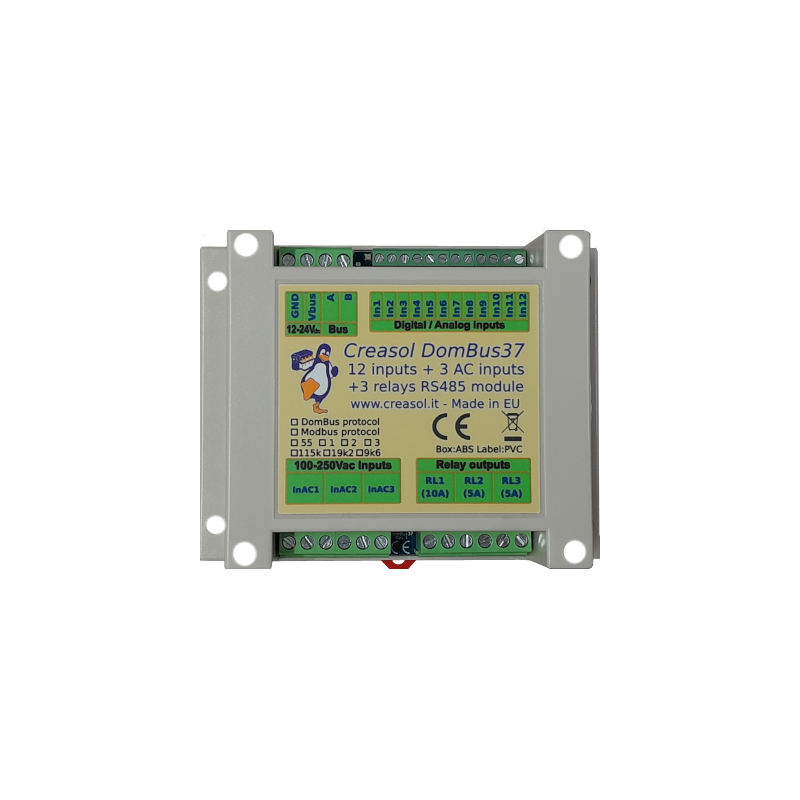
Creasol DomBusTH - Domoticz device with temperature, humidity and touch sensors, 4 inputs, 2 outputs, 3 LEDs
- On sale!
- -25%
Email: store@creasol.it - Telegram: CreasolTech - Whatsapp: +393283730010
Priority mail: fast and cheap - Express Courier: fast and safe
Before returning products, please contact us

DIN RAIL module, 115x90x40mm, supporting both DomBus and Modbus RTU protocols.
It integrates 12x low voltage analog/digital inputs, 3x relays outputs, 3x 115Vac / 230Vac inputs. Optionally it is able to control and monitor the power supply fed to a burglar alarm external siren. Useful to make burglar alarm systems with home automation controllers like Domoticz, Home Assistant, OpenHAB, ...
 Full support: most products are designed by us!
Full support: most products are designed by us!
Email: store@creasol.it - Telegram: CreasolTech - Whatsapp: +393283730010
 Orders are shipped within 1 working day
Orders are shipped within 1 working day
Priority mail: fast and cheap - Express Courier: fast and safe
 24 months warranty, easy return/refund in case of problem
24 months warranty, easy return/refund in case of problem
Before returning products, please contact us
*** Complete information at https://www.creasol.it/DomBus37 ***
Creasol DomBus37 is a DIN RAIL module, 115x90x40mm, supporting both DomBus and Modbus RTU protocols.
It integrates 12x low voltage analog/digital inputs, 3x relays outputs, 3x 115Vac / 230Vac inputs. Optionally it is able to control and monitor the power supply fed to a burglar alarm external siren.
It can be connected to the home automation controller by a RS485 serial bus (4 wires, 2 for 12/24V power supply, and 2 for data at 115200bps).
As other DomBus devices, DomBus37 is designed to consume low power, be reliable, fully configurable and easy to use. Each input port is fully configurable, for example as analog or digital input, twinbutton (double button connected to a single port), counter, buzzer, NTC 10k, ... Analog ports are able to decode single, double, triple, quadruple balanced alarm sensors.
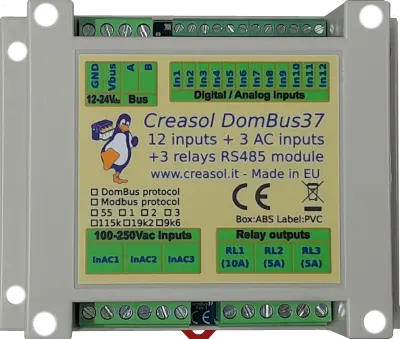
Complete information and application notes at https://www.creasol.it/DomBus37
Default address: 0xff37
| Port# | Name | Capabilities | Default configuration | Description |
| 1 | IN1 | IN_DIGITAL, IN_DIGITAL_PULLDOWN, IN_ANALOG, IN_TWINBUTTON, IN_COUNTER | IN_DIGITAL |
Input, with optional 10k pullup (pcb jumper) and internal pulldown (activated when configured as IN_DIGITAL_PULLDOWN). If connected to a single pushbutton switch or an alarm sensor, the common is GND (when switch is ON, it have to short the port to GND). Can be connected to external NTC thermistor (air or water temperature sensor). |
| 2 | IN2 | IN_DIGITAL, IN_DIGITAL_PULLDOWN, IN_ANALOG, IN_TWINBUTTON, IN_COUNTER | IN_DIGITAL |
Input, with optional 10k pullup (pcb jumper) and internal pulldown (activated when configured as IN_DIGITAL_PULLDOWN). If connected to a single pushbutton switch or an alarm sensor, the common is GND (when switch is ON, it have to short the port to GND). Can be connected to external NTC thermistor (air or water temperature sensor). |
| 3 | IN3 | IN_DIGITAL, IN_DIGITAL_PULLDOWN, IN_ANALOG, IN_TWINBUTTON, IN_COUNTER | IN_DIGITAL |
Input, with optional 10k pullup (pcb jumper) and internal pulldown (activated when configured as IN_DIGITAL_PULLDOWN). If connected to a single pushbutton switch or an alarm sensor, the common is GND (when switch is ON, it have to short the port to GND). Can be connected to external NTC thermistor (air or water temperature sensor). |
| 4 | IN4 | IN_DIGITAL, IN_DIGITAL_PULLDOWN, IN_ANALOG, IN_TWINBUTTON, IN_COUNTER | IN_DIGITAL |
Input, with optional 10k pullup (pcb jumper) and internal pulldown (activated when configured as IN_DIGITAL_PULLDOWN). If connected to a single pushbutton switch or an alarm sensor, the common is GND (when switch is ON, it have to short the port to GND). Can be connected to external NTC thermistor (air or water temperature sensor). |
| 5 | IN5 | IN_DIGITAL, IN_DIGITAL_PULLDOWN, IN_ANALOG, IN_TWINBUTTON, IN_COUNTER | IN_DIGITAL |
Input, with optional 10k pullup (pcb jumper) and internal pulldown (activated when configured as IN_DIGITAL_PULLDOWN). If connected to a single pushbutton switch or an alarm sensor, the common is GND (when switch is ON, it have to short the port to GND). Can be connected to external NTC thermistor (air or water temperature sensor). |
| 6 | IN6 | IN_DIGITAL, IN_DIGITAL_PULLDOWN, IN_ANALOG, IN_TWINBUTTON, IN_COUNTER | IN_DIGITAL |
Input, with optional 10k pullup (pcb jumper) and internal pulldown (activated when configured as IN_DIGITAL_PULLDOWN). If connected to a single pushbutton switch or an alarm sensor, the common is GND (when switch is ON, it have to short the port to GND). Can be connected to external NTC thermistor (air or water temperature sensor). |
| 7 | IN7 | IN_DIGITAL, IN_DIGITAL_PULLDOWN, IN_ANALOG, IN_TWINBUTTON, IN_COUNTER | IN_DIGITAL |
Input, with optional 10k pullup (pcb jumper) and internal pulldown (activated when configured as IN_DIGITAL_PULLDOWN). If connected to a single pushbutton switch or an alarm sensor, the common is GND (when switch is ON, it have to short the port to GND). Can be connected to external NTC thermistor (air or water temperature sensor). |
| 8 | IN8 | IN_DIGITAL, IN_DIGITAL_PULLDOWN, IN_ANALOG, IN_TWINBUTTON, IN_COUNTER | IN_DIGITAL |
Input, with optional 10k pullup (pcb jumper) and internal pulldown (activated when configured as IN_DIGITAL_PULLDOWN). If connected to a single pushbutton switch or an alarm sensor, the common is GND (when switch is ON, it have to short the port to GND). Can be connected to external NTC thermistor (air or water temperature sensor). |
| 9 | IN9 | IN_DIGITAL, IN_DIGITAL_PULLDOWN, IN_ANALOG, IN_TWINBUTTON, IN_COUNTER | IN_DIGITAL |
Input, with optional 10k pullup (pcb jumper) and internal pulldown (activated when configured as IN_DIGITAL_PULLDOWN). If connected to a single pushbutton switch or an alarm sensor, the common is GND (when switch is ON, it have to short the port to GND). Can be connected to external NTC thermistor (air or water temperature sensor). |
| 10 | IN10 | IN_DIGITAL, IN_DIGITAL_PULLDOWN, IN_ANALOG, IN_TWINBUTTON, IN_COUNTER | IN_DIGITAL |
Input, with optional 10k pullup (pcb jumper) and internal pulldown (activated when configured as IN_DIGITAL_PULLDOWN). If connected to a single pushbutton switch or an alarm sensor, the common is GND (when switch is ON, it have to short the port to GND). Can be connected to external NTC thermistor (air or water temperature sensor). |
| 11 | IN11 | IN_DIGITAL, IN_DIGITAL_PULLDOWN, IN_ANALOG, IN_TWINBUTTON, IN_COUNTER | IN_DIGITAL |
Input, with optional 10k pullup (pcb jumper) and internal pulldown (activated when configured as IN_DIGITAL_PULLDOWN). If connected to a single pushbutton switch or an alarm sensor, the common is GND (when switch is ON, it have to short the port to GND). Can be connected to external NTC thermistor (air or water temperature sensor). |
| 12 | IN12 | IN_DIGITAL, IN_DIGITAL_PULLDOWN, IN_ANALOG, IN_TWINBUTTON, IN_COUNTER, CUSTOM | IN_DIGITAL |
Input, with optional 10k pullup (pcb jumper) and internal pulldown (activated when configured as IN_DIGITAL_PULLDOWN). If connected to a single pushbutton switch or an alarm sensor, the common is GND (when switch is ON, it have to short the port to GND). Can be connected to external NTC thermistor (air or water temperature sensor). |
| 13 | INAC1 | IN_AC, IN_COUNTER | IN_AC | Optoisolated input, that can be connected to a circuit breaker (to notify power outages, expecially for fridges and heat pumps), PIRs with 230V output (to monitor presence), light and appliances (to monitor when light or devices are ON). |
| 14 | INAC2 | IN_AC, IN_COUNTER | IN_AC | Optoisolated input, that can be connected to a circuit breaker (to notify power outages, expecially for fridges and heat pumps), PIRs with 230V output (to monitor presence), light and appliances (to monitor when light or devices are ON). |
| 15 | INAC3 | IN_AC, IN_COUNTER | IN_AC | Optoisolated input, that can be connected to a circuit breaker (to notify power outages, expecially for fridges and heat pumps), PIRs with 230V output (to monitor presence), light and appliances (to monitor when light or devices are ON). |
| 16 | RL1 | OUT_DIGITAL, OUT_RELAY_LP, OUT_BLIND,OUT_FLASH | OUT_RELAY_LP | SPST relay output, NO contact, 10A 250Vac or 30Vdc output capability. Relay contact is protected by varistor. |
| 17 | RL2 | OUT_DIGITAL, OUT_RELAY_LP, OUT_BLIND,OUT_FLASH | OUT_RELAY_LP | SPST relay output, NO contact, 5A 250Vac or 30Vdc output capability. Relay contact is protected by varistor. |
| 18 | RL3 | OUT_DIGITAL, OUT_RELAY_LP, OUT_BLIND(1),OUT_FLASH | OUT_RELAY_LP | SPST relay output, NO contact, 5A 250Vac or 30Vdc output capability. Relay contact is protected by varistor. |
| 19 | VBus | CUSTOM | CUSTOM | 12-24V bus voltage, in mW (for example 13508 for 13.508mV) |
| 20 | S.Volt | CUSTOM | CUSTOM | Voltage on the Siren port (IN12 terminal block) in mV. For more information, check paragraph below. |
| 21 | S.Curr | CUSTOM | CUSTOM | Current on the Siren port (IN12 terminal block) in mA. For more information, check paragraph below. |
| 22 | S.On | CUSTOM | CUSTOM | On/Off entity, to enable/disable power supply to the siren. For more information, check paragraph below. |
| 23 | S.State | CUSTOM | CUSTOM | Siren power status. For more information, check paragraph below. |
(1): can be used as BLIND output, to open a blind/curtain, but only the previous port can be configured in Domoticz as OUT_BLIND because, when configured as OUT_BLIND, DomBus device automatically configure the next port to drive a relay in open direction.
The following video shows a presentation of some domotic modules designed and produced in Italy by Creasol to make a reliable, easy and power-optimized home automation system.
The next video shows our Smart EVSE module that can be used to charge the electric car by using only solar power, or adding 25/50/75/100% of available power from the electrical grid.
Our industrial and home automation modules are designed to be
Modules are available in two version:
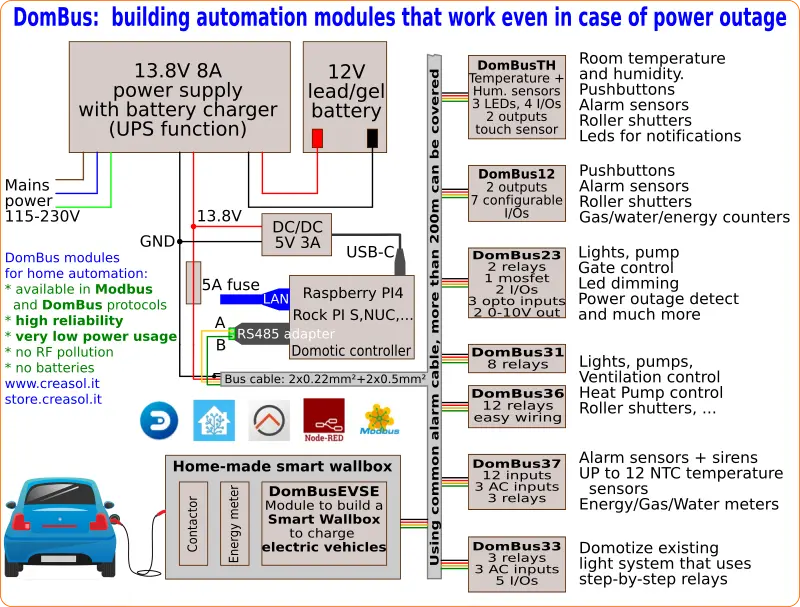
Store website - Information website
For our products we can offer FULL SUPPORT and CUSTOMIZATION: please contact us by Email or Telegram
 Complete solution to make a Smart EVSE, charging the electric vehicle using only energy from renewable source (photovoltaic, wind, ...), or adding 25-50-75-100% of available power from the grid.
Complete solution to make a Smart EVSE, charging the electric vehicle using only energy from renewable source (photovoltaic, wind, ...), or adding 25-50-75-100% of available power from the grid.
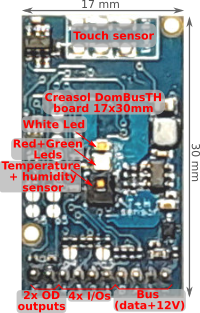 Compact board, 32x17mm, to be installed on blank cover with a 4mm hole in the middle, to exchange air for the relative humidity sensor. It can be installed in every room to monitor temperature and humidity, check alarm sensors, control blind motor UP/DOWN, send notifications (using red and green leds) and activate white led in case of power outage.
Compact board, 32x17mm, to be installed on blank cover with a 4mm hole in the middle, to exchange air for the relative humidity sensor. It can be installed in every room to monitor temperature and humidity, check alarm sensors, control blind motor UP/DOWN, send notifications (using red and green leds) and activate white led in case of power outage.
Includes:
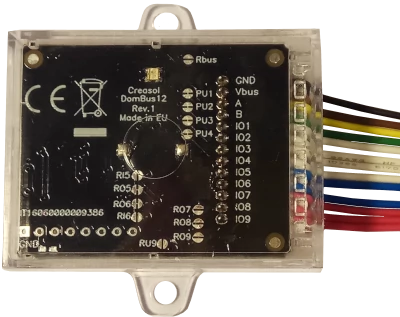 Very compact, versatile and cost-effective module with 9 ports. Each port can be configured by software as:
Very compact, versatile and cost-effective module with 9 ports. Each port can be configured by software as:
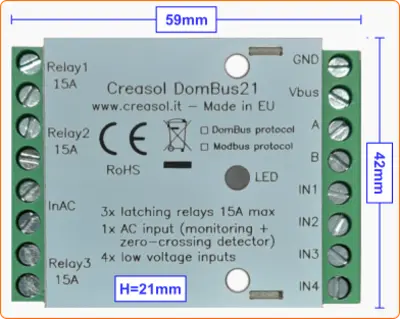 Very low power consumption module designed to enable up to 3 high power loads, up to 15A (3kW).
Very low power consumption module designed to enable up to 3 high power loads, up to 15A (3kW).
 Versatile module designed to control gate or garage door.
Versatile module designed to control gate or garage door.
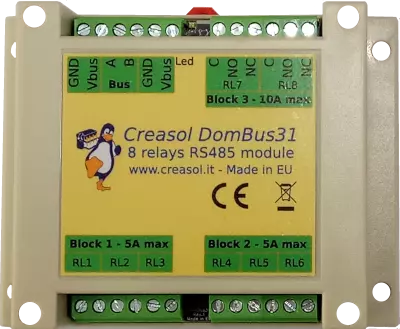 DIN rail low profile module, with 8 relays and very low power consumption:
DIN rail low profile module, with 8 relays and very low power consumption:
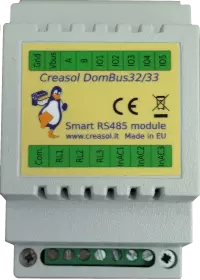 Versatile module with 230V inputs and outputs, and 5 low voltage I/Os.
Versatile module with 230V inputs and outputs, and 5 low voltage I/Os.
 Module designed to control 3 lights already existing and actually controlled by 230V pushbuttons and step-by-step relays. In this way each light can be activated by existing pushbuttons, and by the domotic controller.
Module designed to control 3 lights already existing and actually controlled by 230V pushbuttons and step-by-step relays. In this way each light can be activated by existing pushbuttons, and by the domotic controller.
Each relay can toggle the existing step-relay, switching the light On/Off. The optoisolator monitors the light status. The 5 I/Os can be connected to pushbuttons to activate or deactivate one or all lights.
 DIN rail module, low profile, with 12 relays outputs and very low power consumption.
DIN rail module, low profile, with 12 relays outputs and very low power consumption.
 Module designed to be connected to alarm sensors (magnetc contact sensors, PIRs, tampers): it's able to monitor mains power supply (power outage / blackout) and also have 3 relays outputs.
Module designed to be connected to alarm sensors (magnetc contact sensors, PIRs, tampers): it's able to monitor mains power supply (power outage / blackout) and also have 3 relays outputs.
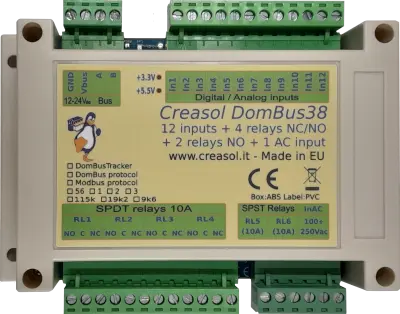 DIN rail module designed for burglar alarm system.
DIN rail module designed for burglar alarm system.
![]() DIN rail module that control azimuth + elevation/tilt motors of a sun tracker, to maximize photovoltaic energy production during the day and seasons.
DIN rail module that control azimuth + elevation/tilt motors of a sun tracker, to maximize photovoltaic energy production during the day and seasons.
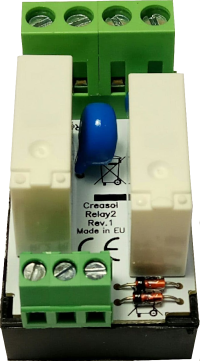 Simple module with 2 relays, to be used with DomBus modules or other electronic boards with open-collector or open-drain outputs
Simple module with 2 relays, to be used with DomBus modules or other electronic boards with open-collector or open-drain outputs
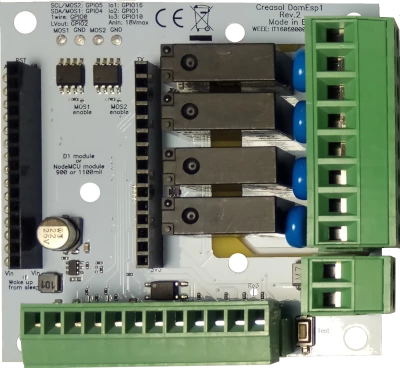 IoT board designed for NodeMCU v3 board using ESP8266 WiFi microcontroller
IoT board designed for NodeMCU v3 board using ESP8266 WiFi microcontroller